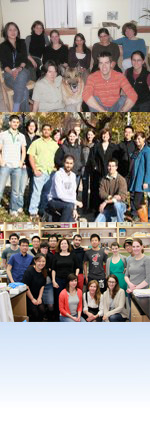
We are interested in how cells become organized into tissues, and how growth is regulated during development. |
|
||
|
Our work focuses on a few main questions How is size controlled? Organs and organisms grow to reproducible sizes, but very little is known on how an organ "knows" what size it is, to consistently control tissue growth. Work in our lab is exploring how Drosophila tumour suppressor gene, called fat, regulates the growth of cells in tissues. Fat is an extremely large (560 kDa) cell adhesion molecule. Loss of Fat yields tissues that are up to 8 times larger than wildtype controls-yet at present, little is known about how Fat restricts growth. Fat regulates growth via the Hippo kinase pathway, a highly conserved pathway that is involved in human cancers. We are trying to understand how Fat controls Hippo pathway activity in flies and mice. We also are investigating how Fat regulates growth via control of metabolism and mitochondrial function. How do cells become assembled into complex, beautifully organized tissues? Intriguingly, Fat also controls a high-level form of tissue patterning, called planar polarity. We want to understand the signal transduction pathway by which this large adhesion molecule regulates tissue organization. we also want to understand if the control of growth and patterning by Fat are linked. We have conducted molecular and genetic screens for elements of the Fat pathway in Drosophila, and are currently dissection the biochemical pathway of Fat signaling. In addition, we have recently identified a human homolog of Fat, and are exploring if Fat regulates proliferation and planar polarity in mammals. How do cells and tissues develop polarity? A serine-threonine kinase, called LKB1 regulates cell polarity in C. elegans, Drosophila, and man. Mutations in LKB1 lead to an increased risk of cancer, suggesting that the control of cell polarity may be important to cancer. We are using genetics and biochemistry in Drosophila to understand how this conserved kinase controls cell polarity. We also are investigating how Fat interacts with cell polarity pathways to regulate planar cell polarity. How is the timing of differentiation controlled? Multicellular organisms must integrate growth and differentiation precisely to pattern complex tissues. Despite great progress in understanding how different cell fates are induced, it is poorly understood how differentiation decisions are temporally regulated. We have recently found that pathways previously shown to regulate cell growth and proliferation have an important role in controlling the timing of differentiation. We are exploring how these pathways regulate differentiation, using molecular and genetic screens in tissue culture models and in Drosophila. |
|||
 |